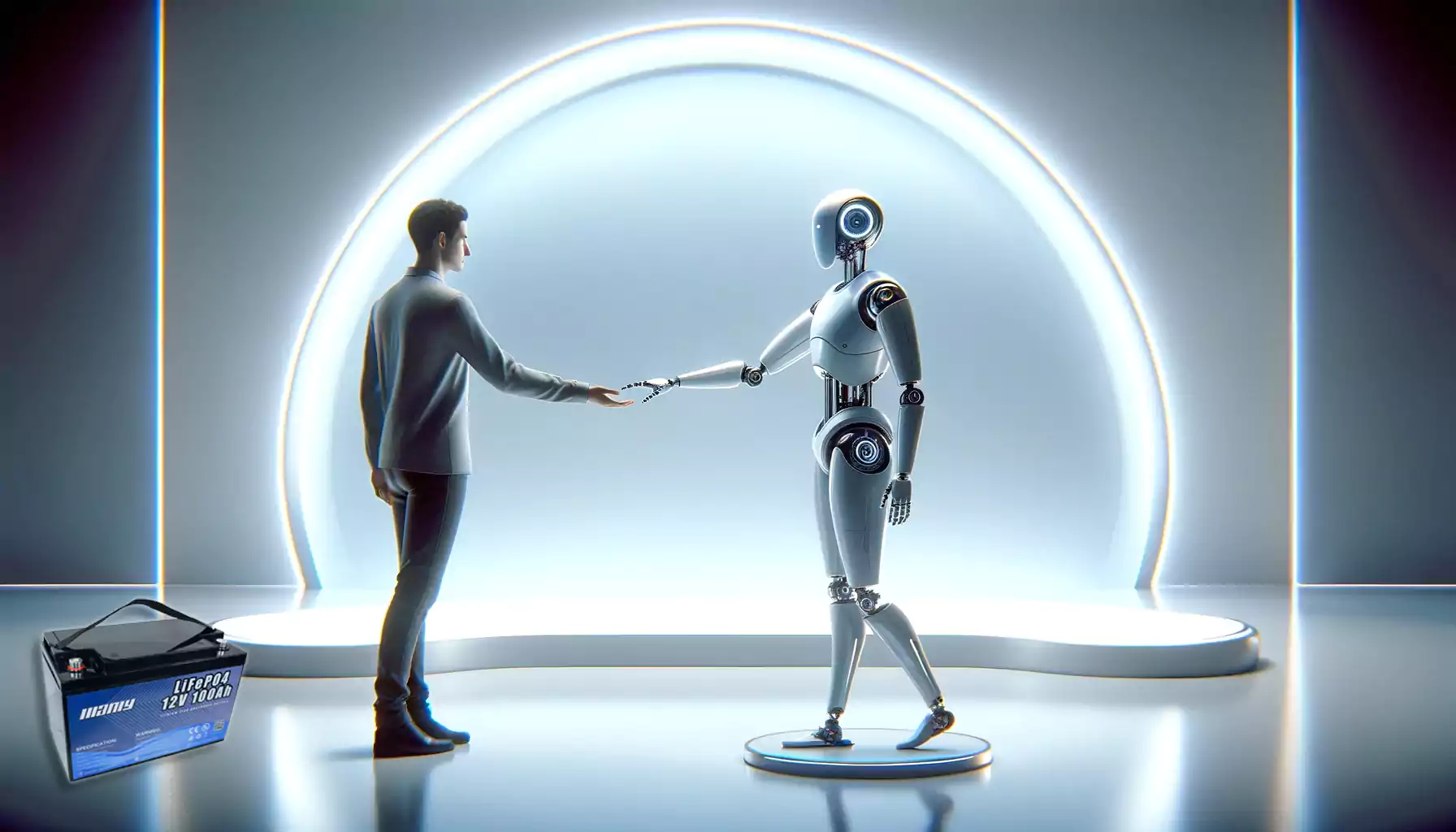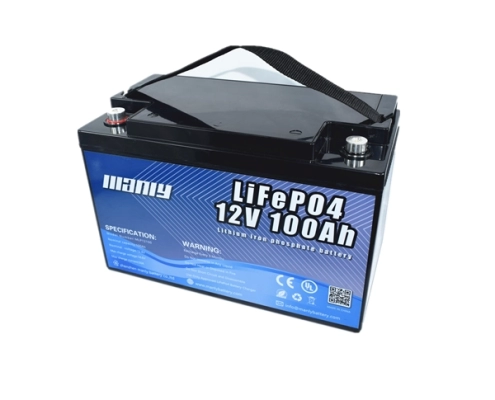What Kind of Batteries Do Robots Use?
Table of Contents
Robots are like the superheroes of machines! They help build cars, clean our floors, and even assist doctors in surgeries. But have you ever wondered what keeps these robots moving and working? Just like you need food for energy, robots need batteries to power them up and keep them going.
Choosing the right battery for a robot is super important. It’s like picking the right kind of fuel for a car. The battery needs to be powerful enough to let the robot do its job, but it also has to fit perfectly in the robot’s “body” and last a long time before needing a recharge.
In this article, we’re going to explore the different types of batteries that robots use. We’ll talk about why some batteries are better for certain robots and how choosing the right battery can make a big difference in how well a robot works. So, if you’re curious to learn more about the cool batteries that power up robots, keep reading!

Understanding Robot Energy Needs
Imagine robots are like different types of cars. Some are big trucks working in factories, doing tough jobs like lifting heavy things. These are called industrial robots. Then, there are smaller cars, like the ones helping in hospitals, hotels, or cleaning your home. These are known as service robots. Each type of robot, just like different cars, needs the right kind of fuel—or in this case, batteries—to keep them going strong and long.
Big and Strong vs. Helpful and Friendly
Industrial robots are the big trucks in the robot world. They are made to do jobs that might be dangerous for people, like working with hot metal or moving heavy parts. These robots are really strong and can work all day and night doing the same job over and over.
Service robots are more like friendly helpers. They do jobs in places like hospitals, hotels, or even your living room. They might not need to lift heavy things, but they have to be smart to work around people, helping without getting in the way.
What Powers These Robots?
- One-Time vs. Rechargeable BatteriesJust like some toys or your TV remote might use batteries you throw away after they’re done, other things like your phone or laptop use batteries you can charge over and over. Robots can use both types, but most of the time, the ones that do big jobs over and over work better with rechargeable batteries. They need to keep going without needing a new battery all the time.
- Energy vs. PowerBatteries are rated by how much electricity they can hold and give out. Think of it like a water bottle; the bigger it is, the more water (or energy) it can hold. But, how fast you can pour that water out is like the battery’s power. Some robots need a slow, steady stream all day, while others might need a big burst of energy to do something fast.
- VoltageThis is like the pressure of the water coming out of the bottle. Different robots need different pressures to work right. Some batteries give a gentle push, while others can give a big shove.
- Working in the Cold or HeatJust like you might feel slow and sleepy when it’s really cold or tired and sluggish when it’s super hot, batteries work differently in different temperatures. Some can’t work in the cold at all, and others don’t like the heat.
Why Does It Matter?
Picking the right battery is like choosing the best snack for energy. You wouldn’t eat a big, heavy meal right before running a race, right? In the same way, choosing the right battery helps the robot do its job the best way possible. Whether it’s lifting heavy things in a factory or helping around the house, each robot needs the right kind of “snack” to keep going.
Types of Robot Batteries
Robots are like different animals in a zoo, each needing its own type of food to stay energetic. For robots, this “food” is their batteries, and there are three main types: Nickel-Metal Hydride (NiMH), Lithium, and Lead-Acid batteries. Each type has its own special qualities, making it the perfect choice for different robot “species.”
1. Nickel-Metal Hydride (NiMH) Batteries
Imagine a small, playful robot toy. These are the types of robots that usually use NiMH batteries. Why? Because these batteries are like a good, affordable snack. They don’t need to give a lot of energy all at once, which is perfect for toy robots that aren’t doing heavy-duty work. Plus, NiMH batteries are safer, making them great for toys that kids can play with.
2. Lithium Batteries
Now, think about robots that are a bit more high-tech, like those that help around the house, compete in robot competitions, or even explore dangerous places. These robots prefer a more powerful “meal” – lithium batteries. Lithium batteries are like a fancy, energy-packed food that gives these robots lots of power without being too heavy. They help the robots move around easily and work for a long time without getting tired.
There are two types of lithium batteries: soft-pack polymer lithium batteries and soft-pack lithium iron phosphate batteries. Polymer lithium batteries are used in robots that need a lot of energy quickly, like in competitions or special missions, because they can release a big burst of power when needed. Lithium iron phosphate batteries are chosen by robots that work in services, like delivering food in restaurants or helping in banks, because they last a long time and don’t need to release a lot of power all at once.
3. Lead-Acid Batteries
Finally, imagine a big, strong robot that doesn’t need to move around much. These robots use lead-acid batteries, which are like a steady, reliable meal that keeps them going. Lead-acid batteries are heavy, so they’re not used in robots that need to move around. Instead, they’re great for robots that stay in one place and need a lot of power to keep running. These batteries have been around for a long time and are pretty good at their job, but they’re not the best for the environment. Because of this, some robots are starting to use lithium iron phosphate batteries instead, which are a cleaner option.
Each type of battery has its own special role, just like different foods are better for different animals. Choosing the right battery helps robots do their best work, whether it’s playing with kids, helping around the house, or doing tough jobs in factories.
Emerging Battery Technologies in Robotics
Imagine a world where robots are even more amazing than they are now, doing things like cleaning oceans or exploring faraway planets! This future is getting closer, thanks to new types of batteries that are being developed. Let’s dive into some of these cool, emerging battery technologies that could change how robots work.
Solid-State Batteries
Think of solid-state batteries as superhero batteries. Unlike regular batteries that have liquids inside them, solid-state batteries use solid materials. This makes them safer – no leaks! They can also store more energy in the same amount of space, which means robots could run longer on a single charge. Imagine a robot that can explore caves or help in disaster areas for days without needing a recharge!
Bio-Batteries
Bio-batteries are like batteries powered by nature. They use materials from living things to create energy. It’s like how plants use sunlight to grow, but here, scientists are trying to use biological materials to power robots. These batteries could be more eco-friendly and could be made from renewable resources, making them a green choice for powering robots.
Flexible Batteries
Flexible batteries are as cool as they sound. They can bend and stretch, which means they can fit into robots of all shapes and sizes, even wearable ones! Imagine a robot that’s as flexible as a gymnast, able to move in ways we can’t yet imagine, all because its battery can twist and turn just like it does.
Wireless Charging Technologies
While not a battery itself, wireless charging is a game-changer for robot batteries. Instead of plugging in a robot to charge, we could have charging stations where robots simply go or even get charged while they are working. It’s like how some smartphones charge without any cords. For robots, this means less downtime and more working time, making them even more helpful.
Why It Matters
These new battery technologies could make robots better friends, helpers, and explorers. They could go places too dangerous for humans and do tasks that take too long for us. With better batteries, robots could help us learn more about our planet and beyond, help in emergencies, and even take on jobs we haven’t thought of yet. The future of robots looks bright, and it’s all powered by these amazing new batteries!
Selecting the Right Battery for Robotics Projects
Picking the perfect battery for a robot is like choosing the right kind of snack for a long hike. You want something that gives you enough energy, lasts a long time, and fits in your backpack just right. Let’s talk about how to pick the best battery for any robot friend or project you’re working on.
Know Your Robot’s Snack Preferences
First, think about what your robot needs to do. Is it going to be running around a lot, like a robot dog playing fetch? Or is it more like a stationary robot that helps you with tasks while staying in one place? Knowing this helps you figure out what kind of “snack” your robot needs.
Size and Weight
Imagine you have a small robot. You wouldn’t want to give it a battery that’s too big or heavy, right? It would be like carrying a giant backpack on a small hike. Make sure the battery fits nicely inside your robot and doesn’t make it too heavy to move around.
How Long It Needs to Run
Think about how long you want your robot to work before it needs a recharge. If you’re building a robot to help clean your room, you’d want it to last long enough to finish the job, not run out of energy halfway through.
The Kind of Power It Needs
Some robots need a lot of power quickly, like a robot that jumps or lifts things. Other robots need less power but for a longer time, like a robot that slowly explores your backyard. Check if the battery can handle the robot’s power needs without getting too tired too quickly.
Rechargeable or Not?
Decide if you want a battery you can recharge or if you’re okay with replacing the battery sometimes. Rechargeable batteries are like having a water bottle you can refill, while non-rechargeable ones are like disposable water bottles. Think about what’s best for your robot and the planet.
Safety and Environment
Safety is super important. Make sure the battery you choose is safe to use in your robot and won’t cause any trouble. Also, think about the environment. Some batteries are friendlier to our planet than others.
Testing and Trying
Sometimes, you might have to try a few different batteries to find the perfect one. It’s like trying different snacks to see which one gives you the best energy for your hike. Don’t be afraid to test and see what works best for your robot.
Asking for Help
If you’re not sure which battery to pick, ask someone who knows a lot about batteries or robots. They can help you make a good choice, kind of like asking a park ranger which trail to take on your hike.
Picking the right battery for your robot is a big part of making sure it works just the way you want. By thinking about what your robot needs to do, how long it needs to work, and making sure the battery is safe and eco-friendly, you can find the perfect “snack” to keep your robot happy and energetic.
The Future of Robotics and Battery Technology
Imagine a world where robots are part of everyday life, helping with everything from delivering packages to assisting doctors, and even exploring space! As technology gets better, robots will become even more amazing. Let’s take a peek into what the future holds for robots and the batteries that power them.
Robots Everywhere!
In the future, robots will be doing even more jobs. They’ll be in hospitals, flying through the sky, and maybe even helping out in your home. As robots start to do more, they’ll need better “food” – and by food, we mean batteries!
Super Batteries on the Way
Batteries are going to get a big upgrade. Scientists are working on batteries that can last longer and pack more power without getting too big or heavy. This means robots could work for days without needing to recharge, making them even better helpers.
Working Together
Imagine robots that can work alongside people safely and smoothly. These robots, called “cobots,” will help with tough jobs without getting in the way. They’ll be smart enough to know when and how to help, making work easier and safer for everyone.
Smarter Robots
Thanks to advances in artificial intelligence (AI), future robots will be super smart. They’ll learn from what they do, making decisions on their own, and understanding the world better. This means they can take on more complex tasks and interact with people and their environment in new ways.
More Robots in Service
Service robots will become more common, doing jobs in healthcare, delivery, hospitality, and retail. These robots will make things more efficient, helping out in ways we can only imagine right now.
Robots That Can Go Anywhere
Some robots will be able to move all by themselves, exploring places where people can’t easily go. They’ll use special sensors and maps to navigate and understand their surroundings, from deep under the ocean to far-off planets.
Robots That Feel and React
Future robots will have advanced sensors that let them “feel” their environment in detail. They’ll see in 3D, recognize objects, and even understand how they’re moving. This will make robots more helpful and safer to be around.
Stretchy and Squishy Robots
New materials will let us build robots that are soft and flexible. These “soft robots” can squeeze into tight spaces or gently pick up delicate items. They’ll be used in places where traditional, hard robots can’t go.
Swarm Robots
Imagine lots of small robots working together like a team of ants. These “swarm robots” can take on big tasks by working together, from cleaning up spills to searching for people lost in the wilderness.
Robotic Exoskeletons
Exoskeletons are wearable robots that make people stronger and more resilient. They’ll help with heavy lifting, assist people with injuries to move better, and even help astronauts in space.
Battery Breakthroughs
To do all these amazing things, robots will need better batteries. Scientists are working on new kinds of batteries that are safer, last longer, and can store more power. Some future batteries might even be flexible or charge up wirelessly!
The future of robotics and battery technology is exciting. With smarter, safer, and more capable robots, the possibilities are endless. From helping out around the house to exploring other planets, the next generation of robots powered by advanced batteries will make the future brighter for everyone.
Conclusion
So, we’ve taken a journey through the world of robots and the batteries that give them life. It’s like discovering how superheroes get their powers from different sources. Some batteries are like snacks, giving robots a quick energy boost, while others are like full meals, keeping them going for a long time.
We learned that picking the right battery for a robot is super important. It’s like choosing the right kind of fuel for a car or the best snack for a hike. We need to think about how big and heavy the battery is, how long it can power the robot, and if it’s safe for the environment.
Looking into the future, robots are going to be even cooler and do more amazing things. They’ll help us in more ways, from doing chores around the house to exploring space. And with new battery technologies on the horizon, these robots will be able to go longer and do more than we ever thought possible.
Remember, the world of robots and batteries is always changing and growing. What seems like science fiction today might be something we use every day tomorrow. So, keep an eye on these exciting changes, because the future of robots and batteries is bright, and it’s going to make our world a more interesting place to live.
In the end, whether it’s playing with a robot dog or sending a robot to Mars, it all comes down to finding the perfect “snack” to keep them powered up and ready for adventure. The adventure of robots and batteries is just beginning, and who knows what amazing things they will do next!
Learn More About Battery
 https://manlybattery.com/wp-content/uploads/2023/09/istockphoto-1140035572-612x612-1.webp
612
408
administrator
https://manlybattery.com/wp-content/uploads/2024/09/Manly-battery-logo2.webp
administrator2023-09-20 15:44:452024-01-05 17:47:58Top Solar Street Light Battery Choices in 2023
https://manlybattery.com/wp-content/uploads/2023/09/istockphoto-1140035572-612x612-1.webp
612
408
administrator
https://manlybattery.com/wp-content/uploads/2024/09/Manly-battery-logo2.webp
administrator2023-09-20 15:44:452024-01-05 17:47:58Top Solar Street Light Battery Choices in 2023 https://manlybattery.com/wp-content/uploads/2022/12/12V-100Ah-4.webp
600
600
administrator
https://manlybattery.com/wp-content/uploads/2024/09/Manly-battery-logo2.webp
administrator2023-09-18 15:48:422023-09-18 15:49:18Lead-Acid vs. Lithium: Solar Battery Showdown
https://manlybattery.com/wp-content/uploads/2022/12/12V-100Ah-4.webp
600
600
administrator
https://manlybattery.com/wp-content/uploads/2024/09/Manly-battery-logo2.webp
administrator2023-09-18 15:48:422023-09-18 15:49:18Lead-Acid vs. Lithium: Solar Battery Showdown https://manlybattery.com/wp-content/uploads/2023/08/12V-200AH-lithium-battery-01.webp
497
850
administrator
https://manlybattery.com/wp-content/uploads/2024/09/Manly-battery-logo2.webp
administrator2023-09-18 14:56:132023-09-20 15:48:032023 Guide: Best Deep Cycle Battery for Solar & RVs
https://manlybattery.com/wp-content/uploads/2023/08/12V-200AH-lithium-battery-01.webp
497
850
administrator
https://manlybattery.com/wp-content/uploads/2024/09/Manly-battery-logo2.webp
administrator2023-09-18 14:56:132023-09-20 15:48:032023 Guide: Best Deep Cycle Battery for Solar & RVs

